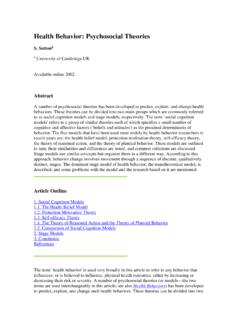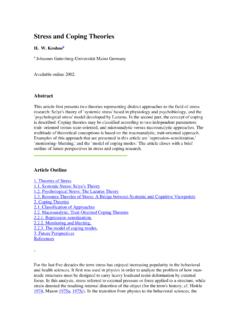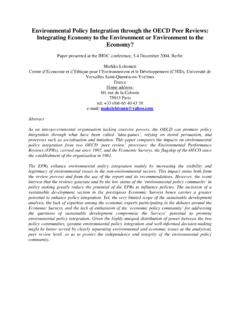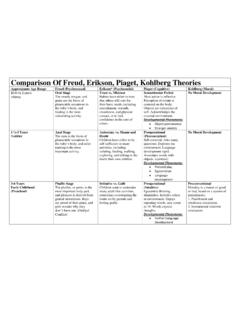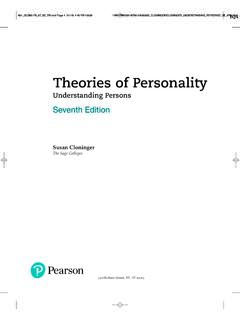Transcription of Health Behavior: Psychosocial Theories - userpage.fu-berlin.de
1 Health Behavior: Psychosocial Theories S. Suttona a University of Cambridge UK Available online 2002. Abstract A number of Psychosocial Theories has been developed to predict, explain, and change Health behaviors. These Theories can be divided into two main groups which are commonly referred to as social cognition models and stage models, respectively. The term `social cognition models' refers to a group of similar Theories each of which specifies a small number of cognitive and affective factors (`beliefs and attitudes') as the proximal determinants of behavior. The five models that have been used most widely by Health behavior researchers in recent years are: the Health belief model, protection motivation theory, self-efficacy theory, the theory of reasoned action, and the theory of planned behavior.
2 These models are outlined in turn, their similarities and differences are noted, and common criticisms are discussed. Stage models use similar concepts but organize them in a different way. According to this approach, behavior change involves movement through a sequence of discrete, qualitatively distinct, stages. The dominant stage model of Health behavior, the transtheoretical model, is described, and some problems with the model and the research based on it are mentioned. Article Outline 1. Social Cognition Models The Health Belief Model Protection Motivation Theory Self-efficacy Theory The Theory of Reasoned Action and the Theory of Planned Behavior Comparison of Social Cognition Models 2. Stage Models 3. Conclusion References The term ` Health behavior' is used very broadly in this article to refer to any behavior that influences, or is believed to influence, physical Health outcomes, either by increasing or decreasing their risk or severity.
3 A number of Psychosocial Theories (or models the two terms are used interchangeably in this article; see also Health Behaviors) has been developed to predict, explain, and change such Health behaviors. These Theories can be divided into two main groups which are commonly referred to as social cognition models and stage models, respectively. These are discussed in turn. 1. Social Cognition Models The term `social cognition models' is used to refer to a group of similar Theories , each of which specifies a small number of cognitive and affective factors (`beliefs and attitudes') as the proximal determinants of behavior. These models do not deny that behavior is influenced by many other factors ( , social structural, cultural, and personality factors), but they assume that the effects of such distal factors are largely or completely mediated by the proximal factors specified by the model.
4 Unlike the distal factors, the proximal factors are assumed to be amenable to change, for example by provision of relevant information. Thus social cognition models can be used as the basis for Health behavior interventions. The Health Belief Model The Health belief model (HBM; Becker 1974) was developed in the 1950s by a group of social psychologists working in the field of public Health who were seeking to explain why some people do not use Health services such as immunization and screening. The model is still in common use. There are four core constructs: the first two refer to a particular disease whereas the second two refer to a possible course of action that may reduce the risk or severity of that disease. Perceived susceptibility (or perceived vulnerability) is the individual's perceived risk of contracting the disease if he or she were to continue with the current course of action.
5 Perceived severity refers to the seriousness of the disease and its consequences as perceived by the individual. Perceived benefits refer to the perceived advantages of the alternative course of action including the extent to which it reduces the risk of the disease or the severity of its consequences. Perceived barriers (or perceived costs) refers to the perceived disadvantages of adopting the recommended action as well as perceived obstacles that may prevent or hinder its successful performance. These factors are commonly assumed to combine additively to influence the likelihood of performing the behavior. Thus, high susceptibility, high severity, high benefits and low barriers are assumed to lead to a high probability of adopting the recommended action.
6 Another factor that is frequently mentioned in connection with the HBM is cues to action (events that trigger behavior), but little empirical work has been conducted on this construct. There have been two meta-analyses (quantitative reviews) of research using the HBM. Janz and Becker ( 1984) calculated significance ratios showing how often each HBM construct was statistically significant in the predicted direction across 46 studies. These ratios were 81 percent for susceptibility, 65 percent for severity, 78 percent for benefits, and 89 percent for barriers; the pattern of findings was similar when only the prospective studies were examined. Thus, barriers is the most consistent predictor of behavior and severity is the least consistent. Harrison et al.
7 ( 1992) used extremely strict inclusion criteria; they included only 16 of the 234 studies they originally identified. Across these 16 studies, the mean correlations between HBM components and behavior were , , , and for susceptibility, severity, benefits, and barriers, respectively. While statistically significant, these correlations are small in substantive terms. Harrison et al. found that benefits and barriers had significantly larger effect sizes in prospective compared with retrospective studies, whereas severity had a significantly larger effect size in retrospective studies. Protection Motivation Theory Protection motivation theory (PMT; Rogers 1983) was originally developed to explain how people respond to fear-arousing Health threat communications or `fear appeals.
8 ' It can be regarded as an adaptation of the HBM. Protection motivation refers to the motivation to protect oneself against a Health threat; it is usually defined operationally as the intention to adopt the recommended action. Of the determinants of intention specified by the model, the four that have received the most empirical attention are vulnerability and severity (equivalent to perceived susceptibility and severity in the HBM), response efficacy (the belief that the recommended action is effective in reducing the threat), and perceived self-efficacy (the belief that one can successfully perform the recommended action; Bandura 1997). Thus, a person will be more motivated to protect himself or herself ( , have a stronger intention to adopt the recommended action) to the extent that he or she believes that the threat is likely if the current course of action is continued, that the consequences will be serious if the threat occurs, that the recommended action is effective in reducing the likelihood or the severity of the threat, and that he or she is able to carry out the recommended action.
9 In many studies using this model ( , Wurtele and Maddux 1987), specific PMT variables are experimentally manipulated in a factorial design and their effects on intention (and sometimes behavior) are measured. In fact, PMT is unique among social cognition models with respect to the relatively large number of experimental tests that have been conducted. To date, two meta-analyses of PMT studies have been conducted (Floyd et al. 2000, Milne et al. 2000). The analyses used different study inclusion criteria and different effect size measures. Floyd et al. analyzed 65 studies with about 30,000 research participants whereas Milne and colleagues included 27 studies with about 8,000 participants. There were only 12 studies in common. Both analyses found support for each of the mainPMT variables as predictors of intentions and/or behavior.
10 Self-efficacy had the strongest, most consistent, and most robust effect. Self-efficacy Theory Self-efficacy theory (SET) is a subset of Bandura's ( 1986) social cognitive theory. According to this approach, the two key determinants of behavior are perceived self-efficacy and outcome expectancies. The latter construct refers to the perceived positive and negative consequences of performing the behavior. See Schwarzer and Fuchs ( 1996) for a version of this model that incorporates risk perceptions and behavioral intention, as well as components of the action phase of behavior change. No meta-analysis of SET has been published, though there is substantial evidence for the predictive validity of self-efficacy (Schwarzer and Fuchs 1996). The Theory of Reasoned Action and the Theory of Planned Behavior The theory of reasoned action (TRA; Ajzen and Fishbein 1980) developed out of social psychological research on attitudes and the attitude behavior relationship.
